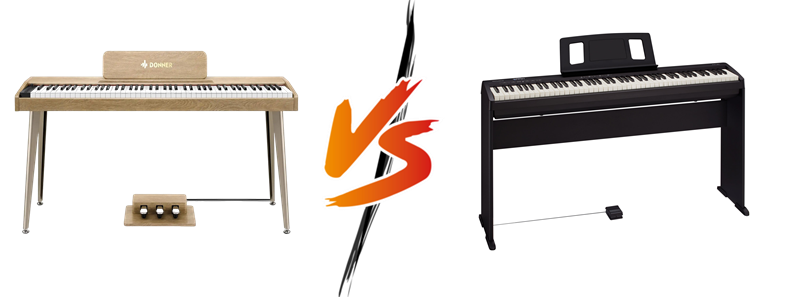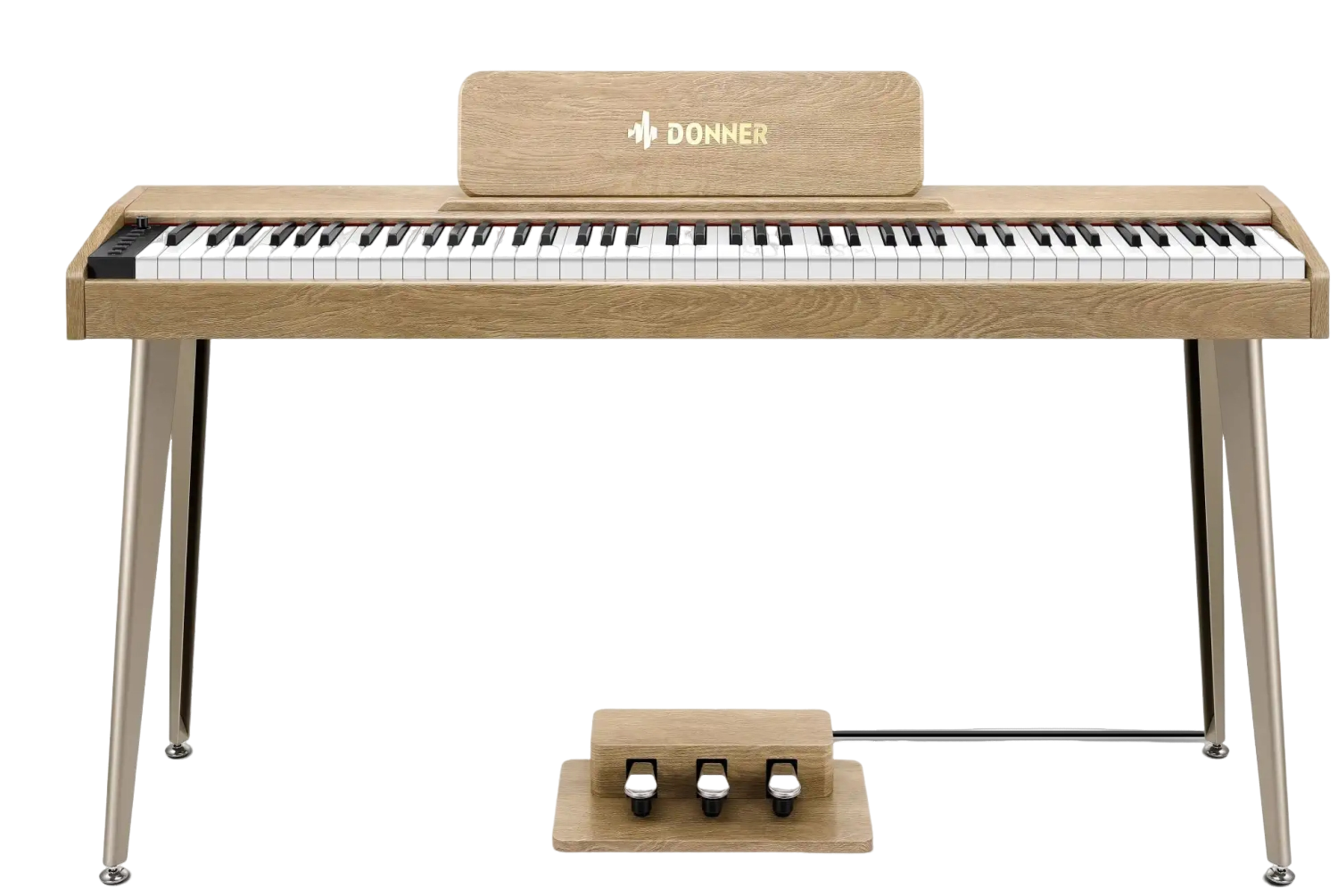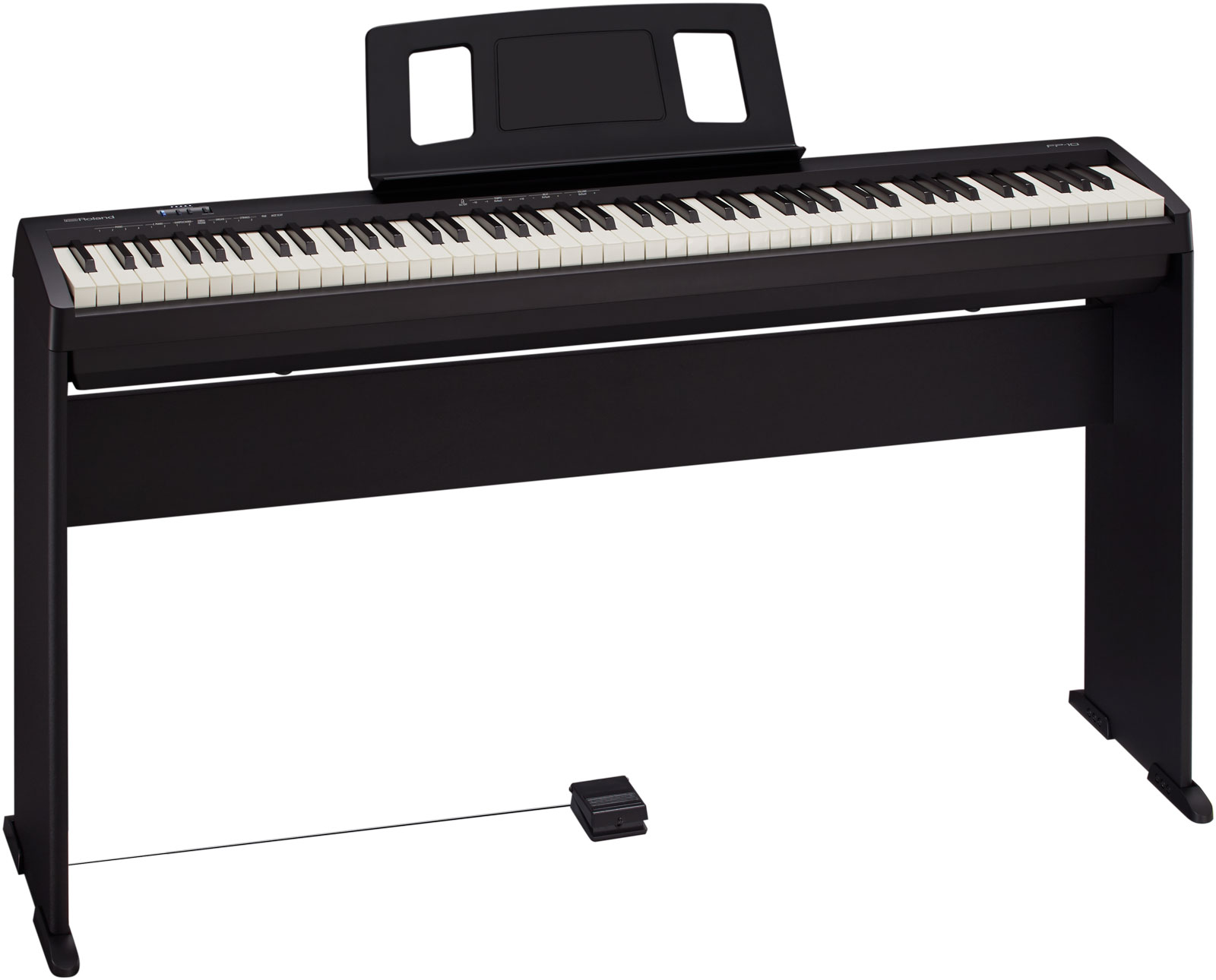Digital pianos have surged in popularity due to their versatility, affordability, and compactness compared to traditional acoustic pianos. It’s time to compare two models that have garnered attention in the entry-level category lately, and are in a similar price category: Donner DDP-60 vs Roland FP-10.

While they are aimed at beginners or intermediate players, both pianos offer unique features that can appeal to different users. In this comparison review, we’ll dive deep into various aspects of these instruments, such as design, keyboard feel, sound quality, speaker performance, functions, connectivity, and overall value for money, among other characteristics. By the end, you’ll have a clearer understanding of which piano might suit your needs better.
Donner DDP-60 vs Roland FP-10 Comparison Chart
Here’s a comparison table outlining the key specifications and features of the Donner DDP-60 and Roland FP-10:
If you click the links below, under the product images you will be redirected to Amazon.com. In case you then decide to buy anything, Amazon.com will pay me a commission. This doesn’t affect the honesty of this review in any way though.
| Feature | Donner DDP-60 | Roland FP-10 |
|---|---|---|
 |  | |
| Check best price on Amazon | Check best price on Amazon | |
| Design | Furniture-style, built-in stand & pedals | Portable, slab-style |
| Weight | 83 lbs (37.5 kg) | 27.1 lbs (12.3 kg) |
| Keyboard Action | Graded Hammer Action | PHA-4 Standard with Escapement |
| Key Material | Plastic, glossy finish | Ivory-feel, synthetic material |
| Number of Keys | 88 fully weighted keys | 88 fully weighted keys |
| Polyphony | 128 notes | 96 notes |
| Sound Engine | Basic sound engine | Roland SuperNATURAL Sound Engine |
| Built-in Voices | 26 voices (pianos, electric pianos, organs, etc.) | 15 voices (pianos, electric pianos, organs, etc.) |
| Speakers | Dual 25W speakers | Dual 6W speakers |
| Bluetooth Connectivity | No | Yes (Bluetooth MIDI) |
| USB MIDI | Yes | Yes |
| Other Ports | Dual headphone jacks, Audio in/out | Headphone jack, USB (no line-out) |
| Pedals | Integrated triple pedal (sustain, soft, sostenuto) | Optional, external pedals |
| Headphone Mode | No specific feature | Headphones 3D Ambience |
| Metronome | Yes | Yes |
| Recording | Yes (basic) | Yes (via apps) |
| App Compatibility | No | Yes (Piano Partner 2, etc.) |
| Price Range | $500 – $600 | $600 – $700 |
| Overall Use Case | Budget-friendly, home-based practice | Portable, modern features, practice & studio |
| My individual reviews | Donner DDP-60 review | Roland FP-10 review |
Design and Build Quality
Donner DDP-60:
The Donner DDP-60 boasts a furniture-style cabinet that mimics the appearance of an acoustic piano. It’s a sturdy, attractive model that fits well in living rooms or practice spaces where aesthetics matter. The DDP-60 comes with a built-in stand and a triple-pedal unit (sustain, soft, and sostenuto), giving it an immediate visual advantage for those seeking a piano with a traditional feel. The wood finish looks sleek and the overall construction is surprisingly robust for its price range.
In terms of weight, the DDP-60 is quite hefty, coming in at around 83 lbs (37.5 kg). It isn’t the most portable piano, but for a stationary setup at home, its solid design gives it a premium feel.
Roland FP-10:
The Roland FP-10, on the other hand, is more minimalist in its design. It is a portable, slab-style digital piano, which means it lacks the furniture-like appearance of the DDP-60. The FP-10’s design is sleek and compact, fitting easily into smaller spaces or for musicians who need something they can move around with. It comes in a matte black plastic finish, which is durable but lacks the traditional elegance that the Donner DDP-60 offers.
However, what the FP-10 lacks in cabinet aesthetics, it makes up for in portability. Weighing only 27.1 lbs (12.3 kg), it’s much lighter and easier to transport than the Donner DDP-60. This makes it ideal for musicians who need a more versatile setup, whether for performances or practice in different locations.
Verdict:
- If you’re looking for a digital piano that can blend into a more traditional or furniture-style home setting, the Donner DDP-60 is the better choice.
- If portability and a minimalist design are more important to you, the Roland FP-10 edges ahead.
Keyboard Action and Feel
Donner DDP-60:
The Donner DDP-60 is equipped with a graded hammer-action keyboard that aims to simulate the weight and feel of an acoustic piano. The keys have a heavier feel in the lower register and get progressively lighter as you move up, similar to a real grand piano. This makes it a good choice for beginners who are looking for a realistic piano-playing experience without spending too much.
The keys themselves are made from plastic and have a glossy finish. While they feel decent, they can become slippery during long practice sessions, especially when your fingers get sweaty. The lack of a synthetic ivory or matte coating on the keys makes it slightly less comfortable for extended playing.
Roland FP-10:
The Roland FP-10 features Roland’s acclaimed PHA-4 Standard action, which is found in their higher-end models. The PHA-4 provides a highly responsive, weighted keyboard with escapement and ivory-feel keys. The inclusion of the ivory texture adds a significant amount of comfort and grip, making the FP-10 a more enjoyable piano to play for extended periods.
Roland’s PHA-4 action is well-known for its expressiveness and ability to respond to subtle changes in touch, which makes it a step ahead of the Donner DDP-60 in terms of playability. Additionally, the escapement mechanism in the FP-10 simulates the feel of a grand piano’s action, giving it a more authentic touch response.
Verdict:
- While the Donner DDP-60 offers a solid hammer-action keyboard that is sufficient for beginners, the Roland FP-10’s PHA-4 Standard action provides a superior playing experience due to its escapement mechanism and ivory-feel keys. For a pianist who values touch sensitivity and long-term comfort, the Roland FP-10 stands out.
Sound Quality and Tone
Donner DDP-60:
The Donner DDP-60 comes with 26 built-in voices, but the focus is on its default piano sound, which is modeled after a concert grand. The piano sound is warm and pleasant, though it lacks some of the depth and nuance found in more premium models. While it’s good for basic practice, more advanced players may find that the DDP-60’s sound engine doesn’t quite capture the subtleties of an acoustic piano, especially when playing more expressive pieces.
The DDP-60’s polyphony is limited to 128 notes, which is decent for most playing styles but could fall short during more complex compositions with heavy use of the sustain pedal.
Roland FP-10:
The Roland FP-10, on the other hand, leverages Roland’s SuperNATURAL sound engine, which is renowned for producing rich, nuanced piano tones. The FP-10’s default piano sound is noticeably more detailed than the DDP-60’s, with greater dynamic range and better note articulation. The lower frequencies are deep and resonant, while the higher notes sparkle without becoming harsh.
Additionally, the FP-10 has 96-note polyphony, which, though lower than the DDP-60, doesn’t seem to affect its performance thanks to its superior sound processing.
When it comes to tonal versatility, the FP-10 shines in its ability to recreate different piano timbres, from soft ballads to more aggressive, bright piano pieces. The overall tonal palette is more refined compared to the DDP-60.
Verdict:
- The Donner DDP-60’s sound engine is competent for its price range, but it can’t match the depth and expression of the Roland FP-10’s SuperNATURAL sound engine. Roland’s engine provides a more authentic acoustic piano experience, making it the better option for those seeking superior sound quality.
Speakers and Sound Projection
Donner DDP-60:
The Donner DDP-60 features dual 25W speakers, which provide plenty of power for home practice. The sound output is quite loud and fills a room easily, making it suitable for small performances or practicing without headphones. The sound quality through the speakers is clear but can sometimes feel slightly muffled or lacking in clarity, especially in the higher registers.
However, the DDP-60’s speakers are more than adequate for casual practice and provide a fuller sound compared to some other entry-level digital pianos.
Roland FP-10:
The Roland FP-10 has dual 6W speakers, which are significantly less powerful than the Donner DDP-60’s setup. However, despite their lower wattage, the FP-10’s speakers offer clear and balanced sound, with excellent projection in small spaces. The FP-10’s speaker system may not be as loud, but it compensates by delivering a more refined and accurate sound that doesn’t distort at higher volumes.
For players who often use headphones, the FP-10 also stands out with its Headphones 3D Ambience feature, which enhances the spatial sound experience when practicing in silence.
Verdict:
- The Donner DDP-60 wins in terms of raw speaker power, making it a better option if you need louder volume without external amplification.
- The Roland FP-10, while quieter, provides clearer sound and offers a more refined listening experience, especially through headphones.
Functions and Features
Donner DDP-60:
The Donner DDP-60 is a relatively straightforward digital piano with a minimalistic control interface. It offers basic functions like metronome, recording, and a handful of reverb settings, but lacks the advanced features found in more expensive models. It does not have an onboard display, so all functions are controlled via button combinations, which might take some time to get used to.
One advantage of the DDP-60 is the inclusion of multiple voices beyond the piano, such as electric pianos, organs, and strings, which can be layered or used individually. However, the quality of these additional sounds is not as high as the main piano voice.
Roland FP-10:
The Roland FP-10 also maintains a simple interface but offers Bluetooth MIDI connectivity, a feature that allows users to connect wirelessly to apps like Roland’s Piano Partner 2 or other DAWs (Digital Audio Workstations) on smartphones, tablets, or computers. This feature is a significant advantage for players looking to practice using modern tools or integrate the FP-10 into a studio setup.
Additionally, the FP-10 supports dual-mode (split keyboard) and twin-piano mode (for lessons), allowing two people to play the same pitch range at once, which is great for teacher-student practice.
While the FP-10 doesn’t come with a wide range of voices (it has 15), the quality of each voice is higher, especially the electric piano and organ sounds. The **
transposition function**, *metronome*, and *recording* options are also easy to access via key combinations or through the Piano Partner app.
Verdict:
- The Donner DDP-60 has more built-in voices and offers basic functionality, making it sufficient for casual players who don’t require advanced tech features.
- The Roland FP-10 takes the lead with its Bluetooth MIDI, app integration, and better learning features, making it a more modern, versatile instrument for tech-savvy users or those wanting to engage in deeper practice.
Connectivity
Donner DDP-60:
The Donner DDP-60 comes with basic connectivity options. It includes:
- USB MIDI port for connecting to computers
- Dual headphone jacks
- Audio in and out ports
These options cover most of the needs for home practice, allowing silent playing through headphones or connectivity to external sound systems.
Roland FP-10:
The Roland FP-10 offers a more modern connectivity suite, including:
- USB MIDI
- Bluetooth MIDI, which allows for wireless connectivity to music apps or DAWs
- Headphone jack (but lacks a dedicated line-out)
The FP-10’s Bluetooth MIDI is a game-changer for musicians looking for wireless control, whether it’s playing through apps, using the piano as a MIDI controller for virtual instruments, or syncing with learning software. However, the lack of traditional audio output ports (like ¼” line-outs) is a drawback for those wanting to use external amplification without relying on adapters.
Verdict:
- The Roland FP-10 excels in modern connectivity, particularly with its Bluetooth MIDI function.
- The Donner DDP-60, while offering basic connections, lacks the advanced wireless functionality that Roland brings to the table.
Price and Value for Money
Donner DDP-60:
The Donner DDP-60 is positioned in the budget-friendly range, typically priced around $500-$600, which makes it an excellent option for beginners or casual players looking for a traditional-looking digital piano at a low cost. For the price, you get a decent keyboard action, adequate sound, and a furniture-style design that’s rare at this price point.
Roland FP-10:
The Roland FP-10 is slightly more expensive, usually priced around $600-$700, but the additional cost is justified by its better keyboard action, sound engine, and Bluetooth connectivity. For those serious about piano, the FP-10 offers a professional-level experience at an entry-level price.
Verdict:
- If you’re looking for an affordable piano that looks like a traditional acoustic instrument and you don’t require advanced features, the Donner DDP-60 provides excellent value for money.
- If you’re willing to spend a bit more for better sound, keyboard feel, and modern features, the Roland FP-10 is the more future-proof investment.
Conclusion: Which One to Choose?
The Donner DDP-60 and the Roland FP-10 cater to different audiences, though both are strong contenders in the entry-level digital piano market.
- The Donner DDP-60 is perfect for those who want a budget-friendly, home-stationed piano with a traditional appearance. It’s great for casual players who prioritize aesthetics and are satisfied with a decent, straightforward playing experience.
- The Roland FP-10, on the other hand, is ideal for players seeking a portable digital piano with a more authentic keyboard feel and superior sound quality. Its Bluetooth MIDI connectivity and PHA-4 Standard action make it the clear choice for tech enthusiasts, advanced students, or anyone looking for long-term growth in their piano playing.
In summary:
- Choose the Donner DDP-60 if you want a piano that looks traditional, sounds decent, and is highly affordable.
- Choose the Roland FP-10 if you prioritize key action, sound quality, and modern connectivity options in a compact, portable form.
